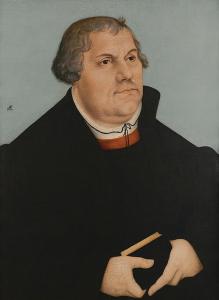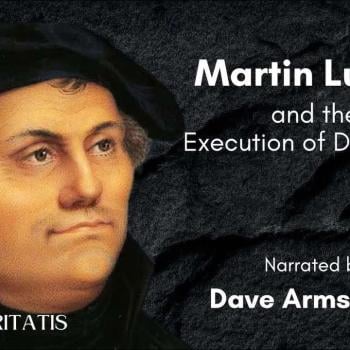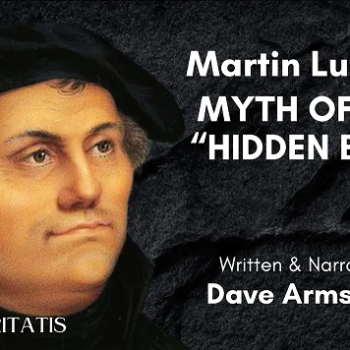
“Please Hit ‘Subscribe’”! If you have received benefit from this or any of my other 4,600+ articles, please follow this blog by signing up (with your email address) on the sidebar to the right (you may have to scroll down a bit), above where there is an icon bar, “Sign Me Up!”: to receive notice when I post a new blog article. This is the equivalent of subscribing to a YouTube channel. Please also consider following me on Twitter / X and purchasing one or more of my 55 books. All of this helps me get more exposure, and (however little!) more income for my full-time apologetics work. Thanks so much and happy reading!
***
Anti-Catholic Reformed Protestant polemicist James Swan, of Boors All infamy, wrote an article on James White’s Alpha & Omega blog, entitled, “Ten Martin Luther Myths” (6-30-07). I will be critiquing #2: “Luther’s Evangelical Breakthrough Occurred in the Bathroom.” Swan’s words will be in blue; Luther’s in green.
Per his usual boorish modus operandi, Swan sets out to make Catholic and other non-Protestant critics of Luther look as ridiculous and inaccurate as possible. He’s tried unsuccessfully to do this to me many times, so I know the process and the mentality very well from firsthand experience. Swan claims it is a “myth, that Luther’s understanding of Romans 1:17-18 came to him while in the bathroom in the tower of the Augustinian cloister.” He wrote in his introduction that he was “amazed certain myths still circulate.” Okay.
Well, we shall see if this is simply mockery and a fable that originated from and is perpetuated by Catholics and other non-Protestants (that we ought to be “amazed” at), or if it actually has historical documentation. I will cite only Protestant or otherwise non-Catholic sources in that regard (lest I simply be accused of producing biased and supposedly inherently untrustworthy Catholic sources). Swan goes on:
In the twentieth century, many approached Luther by applying psychoanalysis to his writings. Psychologist Eric [it’s Erik] Erikson [raised Jewish but not particularly religious] took a German phrase [actually, the primary debate is over a Latin phrase] uttered by Luther and interpreted it literally to mean Luther was in the bathroom when he had his evangelical breakthrough. Erikson concluded, from a Freudian perspective, Luther’s spiritual issues were tied up with biological functions. But, there was not a bathroom in the tower [actually, there was]. The phrase Erikson interpreted literally in German was simply conventional speech. Luther really was saying that his breakthrough came during a time when he was depressed, or in a state of melancholy.
Now, let me make clear, right off the bat, the nature of my motivation in writing this article. I’m not trying to dismiss Luther — or “faith alone ” — merely because of this alleged connection with a bathroom experience. It’s simply a question of the ascertainable facts of history. In and of itself, I couldn’t care less about this “controversy,” and I don’t believe I have ever referred to it in my 34 years of writing about Martin Luther. In fact, I wrote about what is known as Luther’s “tower experience” three weeks ago and never mentioned this aspect at all. Curious, I did an Advanced Search of my blog with its more than 4,600 articles on Google and indeed, no hits came up at all.
But then — here’s the thing — a guy like Swan comes along and confidently asserts that it’s a “myth” and in other places, no doubt, he has blasted Catholics for repeating it. That gets my intellectual curiosity going, so that now I’d like to figure out what we can actually determine — or plausibly speculate — about this purported fact from solid historical sources. I just clarified why I write about Luther, in an article I posted yesterday:
[I am] interested in Christian history, including the founder of Protestantism (who is an extremely fascinating figure). I’ve always loved history in general, and it’s much more interesting to me than fiction. Anomalies like this are interesting and educational by nature.
So — bottom line — it’s simply an interesting question to be looked into. The truth or falsity of “faith alone” obviously doesn’t rest upon whether Luther came up with it during a digestive event or not. Swan denies it, and he has said about 6,987,165 times that he is always a very accurate chronicler of history and All Things Luther (whereas Catholic apologists like myself allegedly are relentlessly wrong about such things). So that, I confess, gives me some extra motivation to write this article as well. It’s a challenge, in other words. I’m responding to his bogus claim. But in any event, it has nothing whatsoever to do with “belittling Luther” etc.
Right away, I discovered an article by a Lutheran “confessional pastor” that examines this issue in considerable depth: “Luther Visualized 5 – The Tower Discovery” (8-25-17). He observes:
The published preface mentioned above [from 1545] was the first time Luther made his gospel rediscovery public. From the Table Talk sources cited above, however, you can see that he had often talked about it privately with his friends before 1545. Most of Luther’s retellings focus exclusively on the content of his discovery. But the 1532 retelling, recorded by both Johannes Schlaginhaufen and Conrad Cordatus, is different. There Luther also makes a point of identifying the location (one gets the impression the group was near the site of the famous discovery at the time): “But when I was in this tower one time (in which there was a privy for the monks), I was speculating on those words [in Romans 1:17].” Another copy of Cordatus’s transcription has: “But when I was in this tower and sweating room…” And after describing his epiphany, he concludes, according to both of his transcribers, “The Holy Spirit introduced this art to me on this latrine” or “on this tower” or “on this latrine on the tower.”
What are we to make of this? I cannot make anything of it except to take Luther at his words. Consider the following: . . .
The plain language of Luther’s description (with several references varying in explicitness) recorded by two different transcribers . . .
In all of his descriptions of his epiphany, Luther never once says he was at his desk or reading; he always says he was speculating or meditating.
The ground floor of the tower had under-floor heating. The warm air from a small stove was led through the pictured conduit under the floor slabs (info marker). Considering that this conduit went right above the latrine, it would have indeed made it a “sweating room.” . . .
According to an info marker outside the excavation in 2013, the tower with the latrine “could only be reached from the monastery” (later Luther’s house after the monastery was gifted to him). This accords with its description in Cordatus’s transcription as “a privy [or private place] for the monks.” . . .
And if you want to find the truth of the gospel in 1518, you have to look in the bathroom at a monk from an ordinary copper miner’s family performing one of life’s less attractive chores.
Luther’s Works, the standard 55+-volume English collection, includes the 1532 Table Talk entry. It translates the phrase in question as “in the tower and heated room of this building” (Vol. 54, 193, No. 3232c). Then it provides an extensive footnote:
This report . . . indicates that Luther’s exegetical discovery took place in a heated room (hypocaustum), which a variant (No. 3232a) calls “the secret place of the monks” and other variants (No. 3232b . . .) appear to call the lavatory (cloaca). Here the meaning of the abbreviation cl. has been the subject of debate, some arguing that it meant “cell” or “chapter” rather than cloaca.
If this [cloaca] is the site of the Reformation discovery, man’s powerlessness is joined by ignominy. Must the trail of the Reformation be followed this far? There is a dignified way out: by cloaca Luther did not mean toilet, but the study up in the tower above it. That, however, would be to miss the point of Luther’s provocative statement. The cloaca is not just a privy, it is the most degrading place for man and the Devil’s favorite habitat. Medieval monks already knew this . . . No spot is unholy for the Holy Ghost; this is the very place to express contempt for the adversary through trust in Christ crucified. (p. 155)
Luther mentions later (ca. Christmas 1531) the rhyme about the devil who catches a monk reading the first breviary prayer of the day while sitting on the toilet: . . .*[Devil: You monk on the latrine, you may not read the matins here!Monk: I am cleansing my bowels and worshipping God Almighty; you deserve what descends and God what ascends.]
TR (Tischreden, or the German version of Table Talk) . . . II, No. 1681 (1532), where the word cloaca, instead of hypocaustum, seems well attested. . . . Cloaca, “privy,” has caused much perturbation to Luther biographers. . . . The privy was probably located in the tower which was removed shortly after Luther’s death. . . . A reference to the privy in this connection would not have been out of line with the realistic speech of Martin and his time. (pp. 198-199)
*
Practical Matters: Perhaps some of my 4,600+ free online articles (the most comprehensive “one-stop” Catholic apologetics site) or fifty-five books have helped you (by God’s grace) to decide to become Catholic or to return to the Church, or better understand some doctrines and why we believe them.
Or you may believe my work is worthy to support for the purpose of apologetics and evangelism in general. If so, please seriously consider a much-needed financial contribution. I’m always in need of more funds: especially monthly support. “The laborer is worthy of his wages” (1 Tim 5:18, NKJV). 1 December 2021 was my 20th anniversary as a full-time Catholic apologist, and February 2022 marked the 25th anniversary of my blog.
PayPal donations are the easiest: just send to my email address: [email protected]. Here’s also a second page to get to PayPal. You’ll see the term “Catholic Used Book Service”, which is my old side-business. To learn about the different methods of contributing (including Zelle), see my page: About Catholic Apologist Dave Armstrong / Donation Information. Thanks a million from the bottom of my heart!
*
***
*
Photo Credit: Portrait of Martin Luther (probably 1540s), by workshop of Lucas Cranach the Elder (1472-1553) [public domain / Wikimedia Commons]
Summary: Anti-Catholic Protestant polemicist James Swan vainly contends that the story of Luther discovering “faith alone” in the bathroom of a monastery tower is merely a “myth.”













